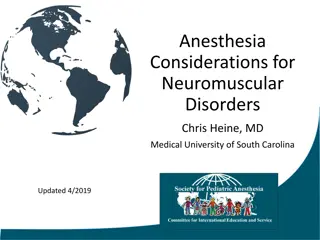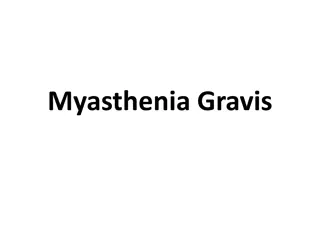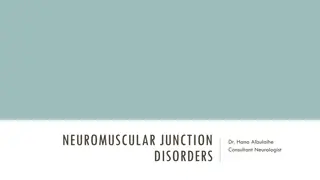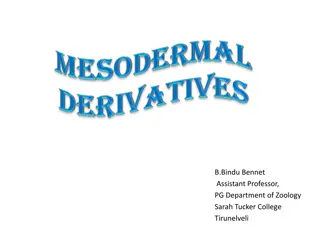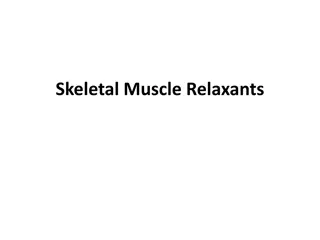Understanding Neuromuscular Transmission and Drug Effects on Frog Rectus Abdominis
The content explores the neuromuscular transmission process in frog rectus abdominis, focusing on the release of Ach and its effects on Nm receptors. It also discusses the impact of different drugs on skeletal muscles, both centrally and peripherally acting, including those that act presynaptically and postsynaptically. Various drug categories and their mechanisms of action are detailed, providing insights into how they influence muscle contraction. Additionally, it compares Nn and Nm receptors, highlighting their differences in smooth and skeletal muscle function.
Download Presentation

Please find below an Image/Link to download the presentation.
The content on the website is provided AS IS for your information and personal use only. It may not be sold, licensed, or shared on other websites without obtaining consent from the author. Download presentation by click this link. If you encounter any issues during the download, it is possible that the publisher has removed the file from their server.
E N D
Presentation Transcript
Lab # 5 Dose Response Curve of Ach & The Effect of Different Drugs on Isolated Frog Rectus Abdominis
Nervous system CNS PNS EFFERENT AFFERENT SOMATIC NERVOUS SYSTEM AUTONOMIC NERVOUS SYSTEM ENTERIC SYMPATHETIC PARA- SYMPATHETIC
Frog Rectus Abdominis: Description: It is a skeletal, voluntary, striated & transverse muscle . It receives somatic motor innervations . The transmission is mediated through release of Ach that acts on Nm Receptors present postsynaptically on the muscle . CNS Neuromuscular (myoneural) junction Skeletal muscle Voluntary motor nerve Nm -R
Neuromuscular transmission: Action potential propagation through nerve fiber . Calcium influx into the nerve ending . Release of Ach from its vesicles (fusion with membrane & exocytosis) . Release of Ach into synaptic cleft . Ach binds to Nm-R postsynaptically . Activation of Na+/K+ channels Na+ influx contraction . Ach action is terminated by cholinesterase enzyme .
Comparison between Nn & Nm: Nn Nm smooth muscle skeletal muscle Located in ganglia Located postsynaptically(MEP)
Drugs that act on skeletal muscles: 1- Centrally acting drugs: e.g. Diazepam (skeletal muscle relaxant) . 2- Peripherally acting drugs: a- Presynaptically . b- Postsynaptically .
Drugs that act on skeletal muscles: Presynaptically acting drugs : 1- AP propagation e.g. local anesthetics 2- Ach synthesis e.g. hemicholinium, vesamicol 3- Ach release e.g. botulinum toxin 4- calcium conc. e.g. Magnesium
Drugs that act on skeletal muscles: Postsynaptically acting drugs: A-Drugs that decrease transmission . B-Drugs that increase transmission .
Drugs that act on skeletal muscles : A- Drugs that decrease transmission Non-depolarizing (Competitive) Competing with Ach at Nm-R . Depolarizing (noncompetitive) MOA They cause initial depolarization followed by persistent depolarization transmission failure receptor blockage . Succinylcholine Decamethonium Examples Tubocurarine Gallamine Type of paralysis produced Flaccid Spastic
Drugs that act on skeletal muscles : B-Drugs that increase transmission: Cholinesterase inhibitors: 1-Reversible: e.g. neostigmine, physiostigmine 2- Irreversible: e.g. organ phosphorus insecticides * Both will lead to accumulation of Ach at myoneural junction .
Dose response curve of acetylcholine The effect of different drugs on the isolated frog rectus abdominis PART 2 PART 1 A W+N W+N W+N N W+N W+N W+N B W N 0.1ml Ach N Physiostegmine 0.1ml Ach 0.1ml Ach Ach 0.05ml 0.2ml Ach 0.4ml Ach Curare 0.1ml 0.1ml Ach Ach 0.1ml 0.1ml Height = A-B






